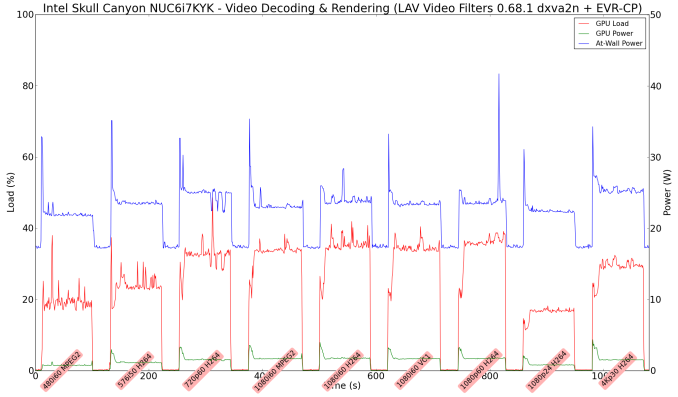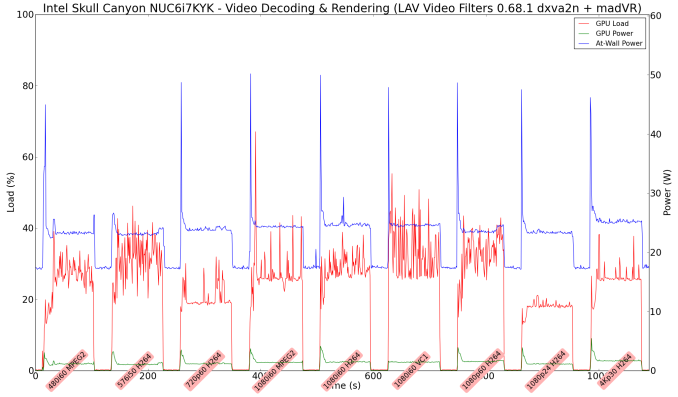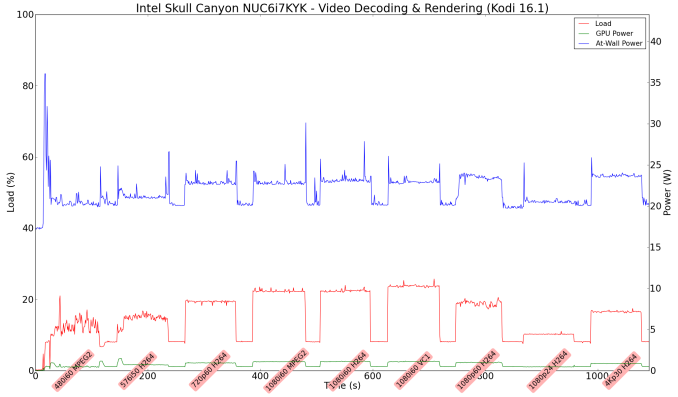The Intel Skull Canyon NUC6i7KYK mini-PC Review
by Ganesh T S on May 23, 2016 8:00 AM ESTHTPC Credentials
The higher TDP of the processor in Skull Canyon, combined with the new chassis design, makes the unit end up with a bit more noise compared to the traditional NUCs. It would be tempting to say that the extra EUs in the Iris Pro Graphics 580, combined with the eDRAM, would make GPU-intensive renderers such as madVR operate more effectively. That could be a bit true in part (though, madVR now has a DXVA2 option for certain scaling operations), but, the GPU still doesn't have full HEVC 10b decoding, or stable drivers for HEVC decoding on WIndows 10. In any case, it is still worthwhile to evaluate basic HTPC capabilities of the Skull Canyon NUC6i7KYK.
Refresh Rate Accurancy
Starting with Haswell, Intel, AMD and NVIDIA have been on par with respect to display refresh rate accuracy. The most important refresh rate for videophiles is obviously 23.976 Hz (the 23 Hz setting). As expected, the Intel NUC6i7KYK (Skull Canyon) has no trouble with refreshing the display appropriately in this setting.
The gallery below presents some of the other refresh rates that we tested out. The first statistic in madVR's OSD indicates the display refresh rate.
Network Streaming Efficiency
Evaluation of OTT playback efficiency was done by playing back our standard YouTube test stream and five minutes from our standard Netflix test title. Using HTML5, the YouTube stream plays back a 1080p H.264 encoding. Since YouTube now defaults to HTML5 for video playback, we have stopped evaluating Adobe Flash acceleration. Note that only NVIDIA exposes GPU and VPU loads separately. Both Intel and AMD bundle the decoder load along with the GPU load. The following two graphs show the power consumption at the wall for playback of the HTML5 stream in Mozilla Firefox (v 46.0.1).

GPU load was around 13.71% for the YouTube HTML5 stream and 0.02% for the steady state 6 Mbps Netflix streaming case. The power consumption of the GPU block was reported to be 0.71W for the YouTube HTML5 stream and 0.13W for Netflix.
Netflix streaming evaluation was done using the Windows 10 Netflix app. Manual stream selection is available (Ctrl-Alt-Shift-S) and debug information / statistics can also be viewed (Ctrl-Alt-Shift-D). Statistics collected for the YouTube streaming experiment were also collected here.

Decoding and Rendering Benchmarks
In order to evaluate local file playback, we concentrate on EVR-CP, madVR and Kodi. We already know that EVR works quite well even with the Intel IGP for our test streams. Under madVR, we used the DXVA2 scaling logic (as Intel's fixed-function scaling logic triggered via DXVA2 APIs is known to be quite effective). We used MPC-HC 1.7.10 x86 with LAV Filters 0.68.1 set as preferred in the options. In the second part, we used madVR 0.90.19.
In our earlier reviews, we focused on presenting the GPU loading and power consumption at the wall in a table (with problematic streams in bold). Starting with the Broadwell NUC review, we decided to represent the GPU load and power consumption in a graph with dual Y-axes. Nine different test streams of 90 seconds each were played back with a gap of 30 seconds between each of them. The characteristics of each stream are annotated at the bottom of the graph. Note that the GPU usage is graphed in red and needs to be considered against the left axis, while the at-wall power consumption is graphed in green and needs to be considered against the right axis.
Frame drops are evident whenever the GPU load consistently stays above the 85 - 90% mark. We did not hit that case with any of our test streams. Note that we have not moved to 4K officially for our HTPC evaluation. We did check out that HEVC 8b decoding works well (even 4Kp60 had no issues), but HEVC 10b hybrid decoding was a bit of a mess - some clips worked OK with heavy CPU usage, while other clips tended to result in a black screen (those clips didn't have any issues with playback using a GTX 1080).
Moving on to the codec support, the Intel Iris Pro Graphics 580 is a known quantity with respect to the scope of supported hardware accelerated codecs. DXVA Checker serves as a confirmation for the features available in driver version 15.40.23.4444.
It must be remembered that the HEVC_VLD_Main10 DXVA profile noted above utilizes hybrid decoding with both CPU and GPU resources getting taxed.
On a generic note, while playing back 4K videos on a 1080p display, I noted that madVR with DXVA2 scaling was more power-efficient compared to using the EVR-CP renderer that MPC-HC uses by default.




















133 Comments
View All Comments
fanofanand - Monday, May 23, 2016 - link
You rebutted your own statement. Casual gamers don't buy $1k mini-PC's. Testing this at super low resolutions can only serve one purpose, which is to provide the appearance of acceptable performance.ganeshts - Monday, May 23, 2016 - link
The point with mini-PC reviews with a gaming focus is that they are spread far apart - we may be lucky to have 3 or 4 in a year.So, it boils down to what we think is more relevant to the reader - a set of benchmark numbers that have to be presented standalone, or a set of benchmark numbers which can be compared apples to apples against some similar previous-generation systems (because, that is what we have the numbers for). We think the latter makes more sense, and that is the reason we are having these 'legacy resolutions' in the gaming benchmarks.
fanofanand - Monday, May 23, 2016 - link
I completely understand why you need to present the information, I just don't think this really meets the "Skulltrail brand" expectations. Skulltrail was always an enthusiast platform designed by enthusiasts. This product looks like it fell victim to marketing requiring a certain thickness of chassis. This product waters down the skulltrail branding, though I guess skulltrail really isn't even relevant anymore. I just don't understand who this is designed for I guess.FMinus - Sunday, August 7, 2016 - link
this really isn't a low budget part, they can get similar or better performance in an ATX form factor for around ~$100 to 200 less.zepi - Monday, May 23, 2016 - link
I'd love to see a ~90W TDP version of this with CPU cores getting about 30W and GPU having 60 or so allocated for it. Even 65W TDP part would be a definite improvement for gaming as CPU / GPU clocks could stay considerably higher during loading of both parts of the chip.With proper cooling it could actually compete decently with low-end discrete graphic laptops. Now it is clear that TDP is limiting it badly.
The question is: How is the perf/w compared to for example A9x GPU parts or Maxwells? Somehow I'm not terribly impressed by Intel's GPU's. Especially considering that they've had their hugely superior manufacturing technology which should help...
Osamede - Monday, May 23, 2016 - link
Power consumption measured with a 1080p display. Is this the real use case?ganeshts - Monday, May 23, 2016 - link
Why not? Not everyone has migrated to 4K yet. I am a first-world tech reviewer, and the max. res monitor that I have is only 2560x1440 :)jhoff80 - Monday, May 23, 2016 - link
Out of curiosity, will there also be an Anandtech review of the new Core M Compute Sticks as well?jaydee - Monday, May 23, 2016 - link
Isn't is kinda a no-brainer to make this thing a little big bigger (with a little better cooling), to avoid throttling? Wouldn't just an inch taller help immensely?ShieTar - Monday, May 23, 2016 - link
Sure, but at ~55mm height it is beginning to look similar in size to a 70 mm high Mini-ITX case, which you can use to build yourself a system with similar compute power, for less than half the system cost.So it really needs to be very flat and very compact to qualify as a niche-product. Asking twice the price for just a 20% difference in some aspect is usually very hard to sell.